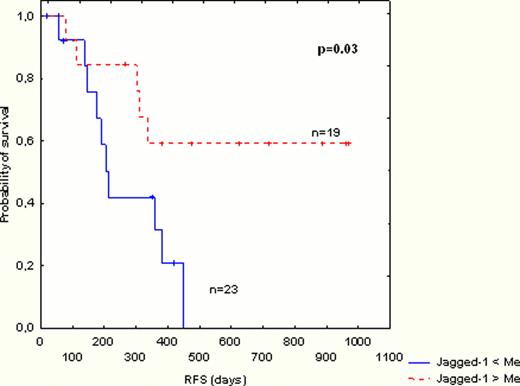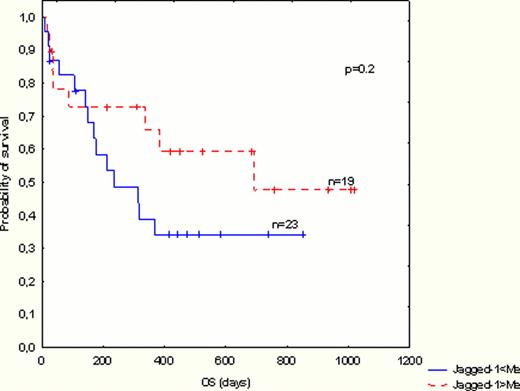Abstract
Abstract 2520
Notch-1 signaling pathway is considered important for acute myeloid leukemia (AML) pathogenesis. Delta-like 1 (DLL-1) and Jagged-1 are functional opposite members of Notch-1 ligand family. There is evidence that Jagged-1 has oncogenic potential whereas DLL-1 is tumor suppressive in AML biology. Moreover, it has been shown that Jagged-1 can promote AML development by stimulation of Notch-1 receptor and in independent manner. The mechanism of DLL-1 function in AML remains unknown. This study was conducted to elucidate the clinical role of Notch-1 and its ligands in AML patients. The expression of Jagged-1, DLL-1 and Notch-1 was estimated in leukemic blasts of newly diagnosed AML patients. Additionally, the level of examined proteins was correlated with known prognostic factors, response to treatment, overall survival (OS) and relapse free survival (RFS).
The Jagged-1, DLL-1 and Notch-1 expression was assessed in leukemic blasts obtained from bone marrow or peripheral blood of 75 AML patients with median age 58 years (21–82y). The expression of proteins was estimated by using multi-color flow cytometry. The isotype controls were performed for all measurements. The percentage of Notch-1, Jagged-1 and DLL-1 positive cells served as protein expression. Based on the median cut-off value patients were subdivided into low-expressers and high-expressers group.
The median (Me) expression of Notch-1 and its ligands Jagged-1 and DLL-1 was 2,2% (range 0,1–24,8%); 20,6% (range 0,9–89,7%) and 3% (range 0,1–35,7%); respectively. Significant correlation between Jagged-1 and Notch-1 protein expression in AML blasts (r=0,24; p=0.048) as well as a trend toward a positive correlation between Jagged-1 and DLL-1 expression (r=0,36; p=0.059) were observed.
The highest expression of Notch-1 and DLL-1 but not Jagged-1 was observed in patients with poor-risk karyotype according to SWOG classification (Me 7,9%; Me 7,65%) as compared to good-risk (Me 1,1%, p<0,045; Me 1,9%, p<0.01) and intermediate-risk group (Me 1,85%, p<0,04; Me 2,8%, p=0.07); respectively. Moreover, we found significantly higher Jagged-1 expression in AML patients with WBC≤10 G/L (Me 24,2%) compared to group with WBC>10 G/L (Me 12,05%, p<0.04). Consequently, the significant negative correlation between Jagged-1 expression and WBC count (r=0.23; p<0.04) was observed.
Forty two of AML patients (56%) received standard induction chemotherapy with daunorubicin and cytarabine +/− cladribine. Unfit elderly patients (n=25, 33%) received repeated courses of azacitidine, decytabine or low-dose cytarabine, and 8 frail patients were allocated to supportive therapy with hydroxyurea only. Twenty six of intensively treated patients (62%) achieved complete remission (CR). The CR rate in high-expressers of Jagged-1 was higher than in the low-expressers group (74% vs. 50%; respectively; p=0.1). In contrast, the CR rate in high-expressers of Notch-1 and DLL-1 was lower than in the low-expressers group (58% vs. 77% and 63% vs. 72%; respectively), however the differences didn't reach statistical significance.
The median OS for intensively treated patients was 12,2 months (95% CI 8,36–14,5). The median RFS and OS for high-expressers of Jagged-1 were longer than in low-expressers group (p=0.03 vs. p=0.2) (Fig. 1AB). In contrast, no relationship between Notch-1 as well as DLL-1 expression and survival was found.
Jagged-1 protein is highly expressed in AML blasts and correlates with lower tumor burden, higher susceptibility to standard chemotherapy and longer RFS in AML patients. Expression of Notch-1 and DLL-1 is higher in poor-risk AML patients but does not influence clinical outcome. These data clearly demonstrate an independent prognostic value of Jagged-1 in AML. A better understanding of Notch-1 signaling pathway in leukemic blasts may create new options for AML therapy.
RFS (A) and OS (B) in high and low-expressers of Jagged-1 protein in AML blasts.
No relevant conflicts of interest to declare.
Author notes
Asterisk with author names denotes non-ASH members.



This feature is available to Subscribers Only
Sign In or Create an Account Close Modal